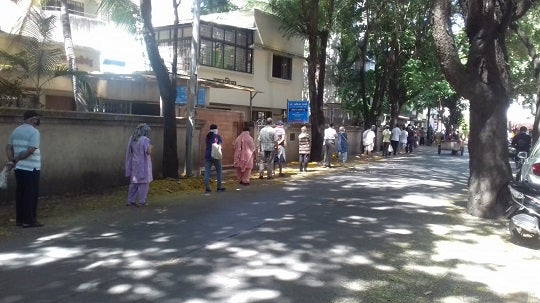Summary
COVID-19 has not yet spread among the communities in India. The country is fighting hard to arrest its spread through severe travel restrictions. Its main challenge is to expand domestic testing and management capacities. Human and financial resources would experience severe pressure if the outbreak does not ebb.
India’s heightened response to tackling COVID-19 coincides with the World Health Organisation describing the outbreak as a pandemic. It also comes at a time when the epicentre of the outbreak has shifted from China to Europe. As on 18 March 2020, less than 40 per cent of 207,860 confirmed COVID-19 affected victims in the world are from China. The virus has now been reported in 166 countries, making it a full-scale global pandemic.
India has 151 confirmed cases till now. Globally, it is still among countries where the virus has not spread deep among the communities. Apart from China, Iran and South Korea in Asia, more than a thousand confirmed cases of COVID-19 have been reported in Italy, Spain, France, Germany, the United States, Switzerland, the United Kingdom, (UK) Netherlands, Belgium, Norway, Austria, Sweden and Denmark. These are countries where COVID-19 has either spread into the communities or is beginning to do so. Till now, India also has had less cases than Japan, Malaysia, Australia, Singapore, Philippines, Thailand and Indonesia from the Asia-Pacific region. Within South Asia, Pakistan has reported 241 cases, making it the highest COVID-19 affected country in the region till now.
These statistics justify the claim by Indian authorities that the virus is yet to graduate from a local transmission to a community transmission stage. More than 800 random samples collected from patients suffering from acute respiratory problems in various parts of the country have tested negative, providing further support to the view. By and large, cases identified positive in India so far can be traced to travellers from Europe, the Middle East and Southeast Asia, and those that they had come into contact with, as well as resident Indians with recent travel histories to these regions.
Even if the detected local cases are mostly ‘imported’, their numbers are going to increase with wider screening and more tests. India’s main thrust, till now, has been on minimising ‘imported’ cases. As a result, it has imposed severe inward and outward travel restrictions. Travellers from Europe, the UK, Turkey, Afghanistan, Philippines and Malaysia have been prohibited from entering India and all flights to these countries have been cancelled. For travellers arriving from several other countries, home quarantines have been advised. Indians have also been asked to refrain from travelling overseas.
The key challenge is to stop the spread from imported cases to community transmission. Here again, the scope and availability of testing facilities become critical. More than 50 government laboratories are currently testing samples. The number is insufficient given that even asymptomatic individuals with travel histories to affected countries are now being tested. More laboratories are being added to the testing network, along with private laboratories. The stockpiles of reagents are also being increased to enhance the capacity to test. The ramp-up, however, cannot happen overnight. Authorities would be hoping that by the time the systemic capacities increase, COVID-19 has not spread exponentially!
As testing capacities increase, the number of positive cases is expected to spike. There are likely to be two resultant impacts. More and more people would want to be tested as knowledge about the infection becomes commonplace, anxieties among the people to check their conditions increase and testing facilities become easier to access. As the testing facilities come under greater pressure, governments – central and state – will need to focus on the availability of human and financial resources. Trained healthcare manpower is already stretched and overworked. It is going to be exceptionally difficult to mobilise more healthcare providers to manage testing and be deployed at isolation quarantines. The central and states governments also need to reflect on the serious risk of other critical non-COVID-9 patients being neglected due to the overriding focus elsewhere.
Testing also involves costs. As of now, tests of symptomatic patients are being conducted free. Government estimates point to initial and confirmatory screenings costing around ₹4,500 (S$87) for each individual. Assuming government laboratories conduct 10,000 tests daily across the country in the days to come, the total costs would be ₹45 million (S$870,000) for each batch of 10,000, including their later screenings. Provided free, the costs would be enormous for central and state agencies to absorb and sustain over time.
India has allocated US$10 million (S$14.4 million) to an emergency fund to manage COVID-19 in the South Asian region. Much more might be needed to manage affairs at home. The required funds, apart from those to ramp up testing and other preventive capacities, will include the financial stimulus, critical for an economy already in the throes of a slowdown and poised to experience further economic contraction due to COVID-19. Managing the economic impact of COVID-19 might be a tougher challenge for the government than addressing its public health impacts.
. . . . .
Dr Amitendu Palit is a Senior Research Fellow and Research Lead (Trade and Economic Policy) at the Institute of South Asian Studies (ISAS), an autonomous research institute at the National University of Singapore (NUS). He can be contacted at isasap@nus.edu.sg. The author bears full responsibility for the facts cited and opinions expressed in this paper.
-
 More From :
More From :
-
 Tags :
Tags :
-
 Download PDF
Download PDF



